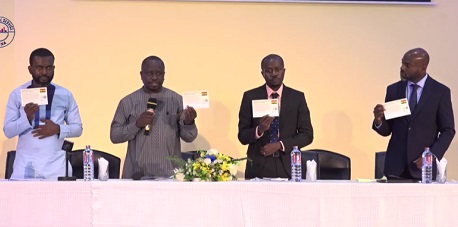
Ghana Statistical Service unveils 2019 Social Accounting Matrix (SAM) data
The Ghana Statistical Service (GSS) has collaborated with the International Food Policy Research Institute (IFPRI) and the Institute of Statistical, Social, and Economic Research (ISSER) to release the comprehensive 2019 Social Accounting Matrix (SAM) economy-wide database.
A Social Accounting Matrix (SAM) serves as a comprehensive record of financial transactions, encompassing all economic interactions involving payments and receipts. It provides an extensive and cohesive overview of economic exchanges occurring within a nation.
The Ghana 2019 SAM project is part of the Nexus initiative, supported by the USAID, Bill and Melinda Gates Foundation, and the Consortium of International Agricultural Research Centres (CGIAR).
This database marks the third iteration of the Ghana SAM series, with previous editions released in 2007 and 2017.
The Country Team Representative of IFPRI, Seth Asante elucidated the project's objectives, highlighting its role in establishing uniform data standards, methodologies, and classification systems for constructing and updating national SAMs. These matrices play a pivotal role in country-level computable general equilibrium (CGE) modeling.
Mr. Asante emphasized the database's importance in facilitating policy analysis by offering a standardized platform for economists and policymakers. This platform aids in understanding the economy's structure, thus enabling effective policy implementation and identification of economic vulnerabilities.
Despite the Ghana 2019 SAM utilizing data from 2022 for its analyses, the year 2019 provided the baseline for predicting and addressing shocks. This approach considers external factors such as the impact of the Covid-19 pandemic and the Russia-Ukraine conflict, allowing for more accurate estimations.
The database revealed insights into the production and trade structure of agriculture, industry, and services sectors in 2019. It further detailed household income sources, population figures, and expenditure trends.
In terms of sectoral contributions to GDP, agriculture accounted for 18.5%, with crops contributing 14.6%. The industry sector registered a total GDP of 33.2%, with manufacturing and mining as its major drivers at 13.3%. In the services sector, wholesale and retail trade led with an 18.7% contribution, contributing to the overall 48.2% GDP share in 2019.
The data also shed light on consumption patterns, revealing that impoverished and rural households allocated 52.8% of their consumption spending to food, resulting in a 3.5% saving rate. Urban households allocated 37.2% of their expenditures to food and maintained a higher savings rate of 9.6%.
Government Statistician, Prof. Samuel Kobina Annim, expressed optimism about the widespread utilization of the Ghana 2019 SAM data. He emphasized the SAM's ability to offer disaggregated insights, enabling a deeper understanding of the economy's structure and its various components.
Prof. Annim stated, "The SAM is one of the statistical products that allows us to deal with the disaggregate and understand the structure of the economy. So if we do not take up these statistics and continue to work with a GDP figure, we won’t be taking the country anywhere. This is the statistical product that will tell us whether the economy is moving in a positive direction or not."
